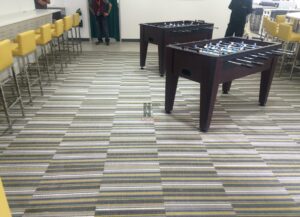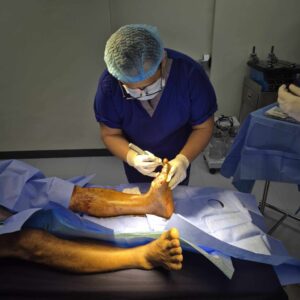Wound care has advanced significantly in recent years, with new technologies transforming how healthcare providers manage chronic wounds. One of the most promising innovations in this field is ultrasonic wound debridement, a cutting-edge technique that plays a critical role in accelerating healing and preventing complications. Wound debridement is the process of removing dead, infected, or non-viable tissue to create a healthier environment for healing. Without proper wound debridement, recovery may be delayed, and the risk of infection increases. Kalingap Wound Care Clinic, a trusted leader in the field, offers expert wound debridement services in Quezon City, including ultrasonic wound debridement for faster and safer healing outcomes.
What Is Ultrasonic Wound Debridement?
Ultrasonic wound debridement is a minimally invasive technique that uses low-frequency ultrasonic energy to selectively remove necrotic tissue from wounds. Unlike surgical debridement, which may require anesthesia and carries higher risks, ultrasonic wound debridement is gentle, precise, and can be performed on an outpatient basis. The procedure uses ultrasonic vibrations to break down devitalized tissue, bacteria, and biofilm without harming surrounding healthy skin. This method of wound debridement is increasingly used in modern wound care due to its ability to treat complex wounds with minimal discomfort.
How Ultrasonic Wound Debridement Works
The principle behind ultrasonic wound debridement is based on the science of cavitation and microstreaming. When the ultrasonic device is applied to the wound, microscopic bubbles form and collapse rapidly, creating powerful mechanical forces that dislodge dead tissue and bacterial colonies. The technology allows clinicians to perform wound debridement more effectively by targeting only the non-viable tissues, ensuring healthy cells remain intact and undisturbed. Tools commonly used in the procedure include handheld ultrasonic probes and irrigating systems that deliver saline to flush out debris. At Kalingap Wound Care Clinic, this technology is used in combination with thorough wound assessments to tailor treatment plans to each patient’s needs.
Benefits of Ultrasonic Wound Debridement
Ultrasonic wound debridement offers several advantages over traditional methods. First, it significantly reduces healing times by accelerating the removal of barriers to tissue regeneration. Second, the procedure is less painful than other forms of wound debridement, often requiring little to no anesthesia. Third, it lowers the risk of infection by efficiently eliminating bacteria-laden debris and biofilm from the wound bed. Additionally, this technique preserves healthy tissue, which is crucial for long-term healing and minimizing scarring. Patients at Kalingap Wound Care Clinic experience improved comfort and compliance thanks to the gentle yet effective nature of ultrasonic wound debridement. As one of the most advanced forms of wound care available, it ensures better outcomes and greater patient satisfaction.
Conditions Treated with Ultrasonic Wound Debridement
Ultrasonic wound debridement is particularly effective in managing chronic and hard-to-heal wounds. Common conditions that benefit from this treatment include diabetic foot ulcers, which are prone to infection and require meticulous care to prevent amputation. Pressure sores, also known as bedsores, respond well to ultrasonic wound debridement due to the technique’s ability to remove slough and promote new tissue growth. Venous leg ulcers, which are often recurrent and resistant to standard treatments, also heal more quickly with this method. Additionally, surgical wounds with delayed healing and infected wounds containing necrotic tissue can be successfully managed using ultrasonic wound debridement. Patients seeking reliable and expert treatment for these conditions can count on Kalingap Wound Care Clinic, where comprehensive wound debridement services are performed with skill and compassion.
Comparison with Traditional Debridement Methods
Compared to surgical wound debridement, ultrasonic wound debridement is significantly less invasive and does not require an operating room setting. While surgical debridement can be effective for large wounds with extensive necrosis, it carries more risks, such as bleeding, pain, and anesthesia complications. Mechanical debridement, which uses gauze or pads to scrub away dead tissue, can be painful and non-selective, often damaging healthy tissue in the process. Enzymatic debridement, which uses topical agents to break down necrotic tissue, works slowly and may not be sufficient for infected wounds. In contrast, ultrasonic wound debridement provides a balanced approach: it’s fast, precise, and preserves viable tissue. For patients seeking a modern and less traumatic wound care solution, Kalingap Wound Care Clinic offers ultrasonic wound debridement as a safer and more efficient alternative to outdated methods.
Safety and Efficacy
Ultrasonic wound debridement has been validated by numerous clinical studies for its safety and efficacy. It is suitable for a wide range of patients, including those with compromised immune systems, diabetes, or poor circulation. The risk of complications is low, and the selective action of the ultrasonic energy ensures that only necrotic material is targeted. Furthermore, this method of wound debridement promotes angiogenesis (formation of new blood vessels) and cellular activity, both of which are essential for rapid healing. Kalingap Wound Care Clinic adheres to the highest safety standards when performing ultrasonic wound debridement, ensuring that every patient receives personalized, high-quality care from trained professionals.
What Patients Can Expect During the Procedure
During an ultrasonic wound debridement session, the clinician will first evaluate the wound to determine the appropriate settings and tools. The procedure itself is typically done at the bedside or in a treatment room and takes only a few minutes, depending on the wound size. Patients may feel a mild tingling or buzzing sensation but usually report little to no pain. After the procedure, the wound is cleansed, dressed, and monitored for signs of improvement. Follow-up visits may be scheduled to track progress and repeat the treatment if necessary. Kalingap Wound Care Clinic ensures that patients are fully informed and supported throughout the wound debridement process, from consultation to recovery.
The Future of Wound Care
The integration of ultrasonic wound debridement into standard practice signals a new era in wound care. As technology continues to evolve, we can expect even more refined techniques and smarter tools that enhance the precision and outcomes of wound debridement. Moreover, the rise of telemedicine and digital wound monitoring tools complements in-person treatments like ultrasonic wound debridement, enabling a more holistic and data-driven approach to healing. Clinics like Kalingap Wound Care Clinic are at the forefront of this transformation, combining expert care with the latest innovations to ensure the best possible outcomes for their patients.
Takeaway
Ultrasonic wound debridement represents a breakthrough in the field of wound care, offering a safer, faster, and more comfortable alternative to traditional methods. This advanced technique improves healing times, reduces pain, and lowers the risk of infection by targeting only the damaged tissue. Consistent and expert wound debridement is essential for managing chronic wounds and restoring health. For those seeking trusted, modern wound care solutions in the Philippines, Kalingap Wound Care Clinic stands out as the premier provider of ultrasonic wound debridement and comprehensive wound care services. Don’t let chronic wounds compromise your quality of life—book a consultation with Kalingap today and take the first step toward faster healing.











